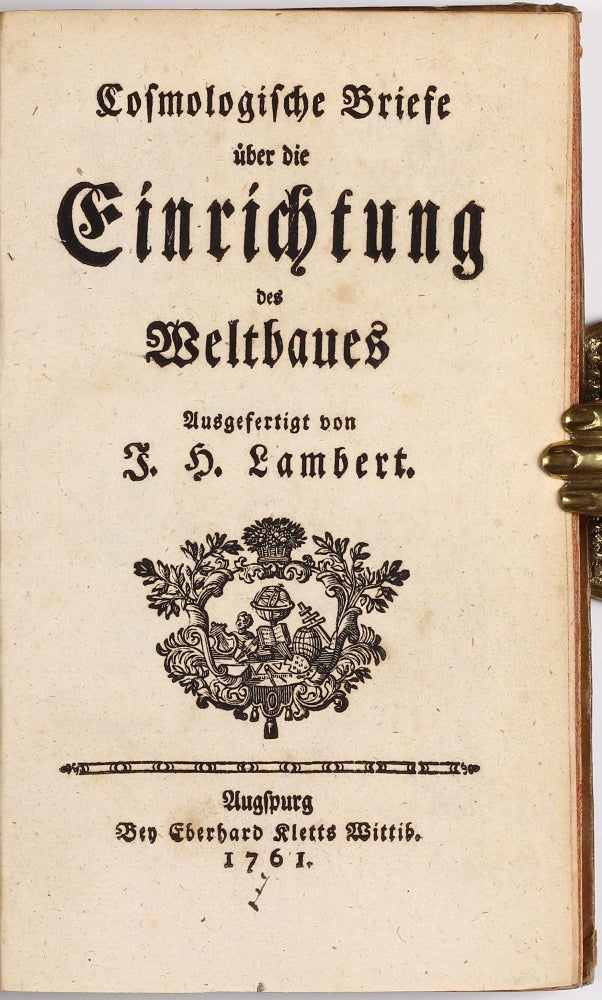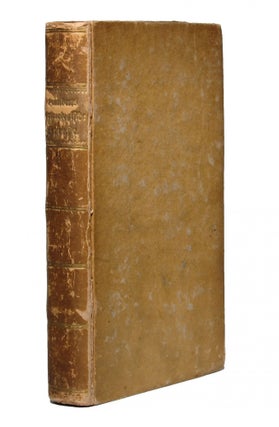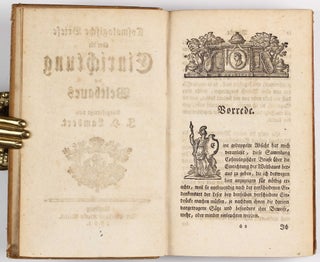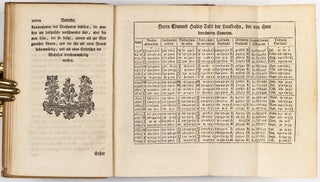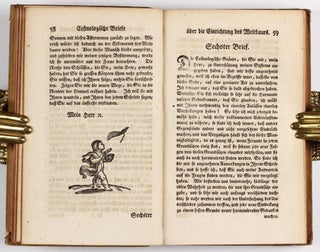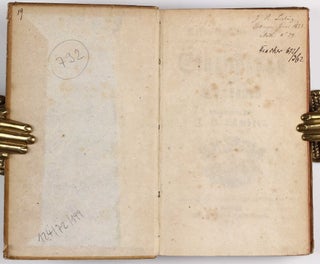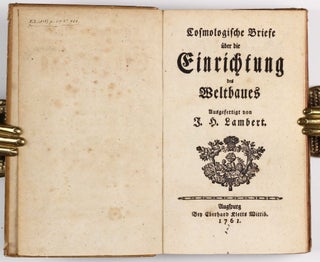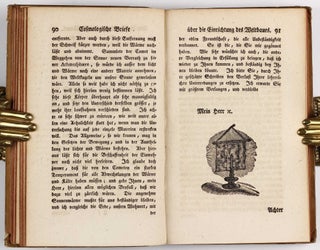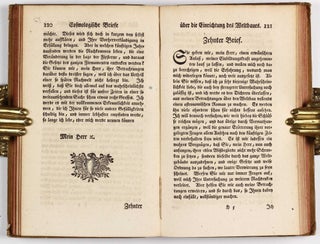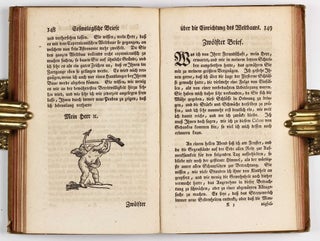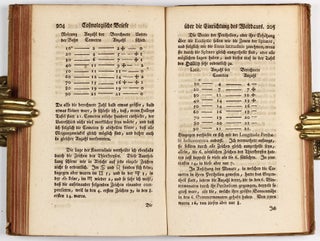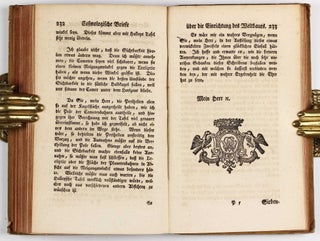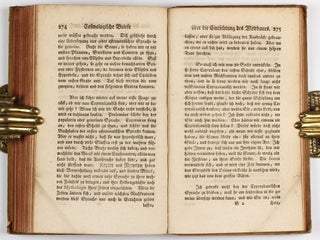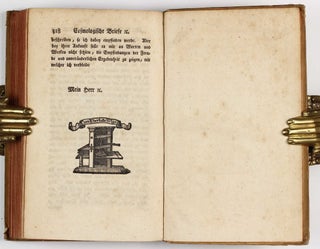A vision of the constitution of the universe
Cosmologische Briefe über die Einrichtung des Weltbaues.
Augsburg: Eberhard Kletts Wittiv, 1761.
1st Edition. Hardcover. Very Good. Item #001707
8vo (194 x 120 mm). xxviii, 318 pp., woodcut printer's device to title and final page, woodcut initials, head- and tailpieces, folding letterpress table. Near contemporary German card board, spine with gilt lettered label and gilt ruling, red-sprinkled edges (spine rubbed, label with minor loss of gilt lettering, corners worn).Text with light even browning, occasional very minor spotting. Provenance: Johann Benedict Listing* (ownership entry on first free endpaper, "J. B. Listnig (sic!), Göttingen, June 1833"). A handsome copy in untouched original binding. ----
Houzeau-L. 8886. Poggendorff I, 1355 ; Goed. IV 1, 479, 1. Ziegenfuss II, 11. - The scarce first edition of Lambert's sensational "Cosmological Letters", his most important astronomical work, in which he to a large extent fore-shadowed the documentation of the basic features of the universe that Herschel later carried out. The work became very popular and was translated into French, Russian, and English, and it was later re-written and published as "Systeme du Monde" in Berlin, 1770. "Of special interest among Lambert's astronomical writings - apart from applications of his physical doctrines - are his famous Cosmologische Briefe über die Einrichtung des Weltbaues" (Augsburg, 1761). Not familiar with the similar ideas of Thomas Wright (1750) and with Kant's "Allgemeine Naturgeschichte und Theorie des Himmels" (1755), Lambert had the idea that what appears as the Milky Way might be the visual effect of a lens-shaped universe. On this basis he elaborated a theory according to which the thousand of stars surrounding the sun constituted a system. Moreover he considered the Milky Way as a large number of such systems, that is, a system of higher order... Only when William Hershel systematically examined the heavens telescopically and discovered numerous nebulae and "telescopic milky-ways" did it become obvious that Lambert's description was not mere science fiction but to a large extent a bold vision of the basic features of the universe" (Scriba in D.S.B. VII:598). --- Kant's mentor (Martin Knutzen) died in 1755, three years before the pre-critical project unfolded. But Kant still had the chance of meeting kindred spirits. One of these was the great philosopher and mathematician Johann Heinrich Lambert, whom he admired a great deal. Finally he had encountered a thinker who appreciated both the scientific and metaphysical perspective, who worried about their tensions, and who was searching for a truce. In his "Cosmologische Briefe..." (Cosmological Letters on the establishment of the universe), Lambert worked on the same topic as Kant had worked on in his earlier Universal Natural History. The tasks and results of both works resemble each other, in so far as they were both proposals of integrating Newtonian physics into a larger framework, and they both contained a theory of the dynamic constitution of the universe. Furthermore, as Kant's scientific works should be viewed under the perspective of his general philosophical outlook, so must Lambert's work in physics and astronomy be seen in relation to his general philosophical outlook and his perpetual quest for introducing mathematical exactness into the sciences. "Lambert's efforts to improve communication and collaboration in astronomy were noteworthy. He promoted the publication of astronomical journals and founded "Berliner astronomisches Jahrbuch oder Ephemeriden". Many of the articles that he contributed to it were not published until after his death... He also favored the founding of the Berlin observatory. These suggestions, in line with Leibniz' far-reaching plans for international cooperation of scientific societies, inaugurated a new period of scientific teamwork." (D.S.B., VII:598).
*Johann Benedict Listing (1808-1882) was a German mathematician and physicist.He studied mathematics and architecture at the University of Göttingen. He received his doctorate there in 1834. Thereafter he made a three-year journey with Wolfgang Sartorius of Waltershausen to investigate the volcanic activity of Mount Etna in Sicily. In 1837 he became a teacher of mechanical drawing, machine science and applied mathematics at the Higher Industrial School in Hanover, and in 1839, associate professor of physics as successor to Wilhelm Eduard Weber and 1849 professor of mathematics in Göttingen. Through his mentor Carl Friedrich Gauss, Listing began to specialize in the topology, which at that time was still called analysis situs. He first introduced the term "topology", in a famous article published in 1847, although he had used it in correspondence some years earlier. He (independently) discovered the properties of the half-twisted strip at the same time (1858) as August Ferdinand Möbius, and went further in exploring the properties of strips with higher-order twists (paradromic rings). He discovered topological invariants which came to be called Listing numbers.
Price: 1,400 € * convert currency
Delivery time up to 10 days. For calculation of the latest delivery date, follow the link: Delivery times
Lieferzeit max. 10 Tage. Zur Berechnung des spätesten Liefertermins siehe hier: Lieferzeiten


